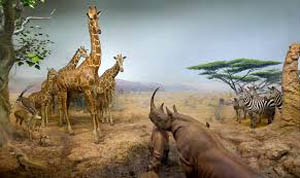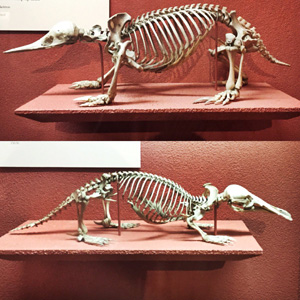When I was a small boy, my father would periodically take me up to the Field Museum. I was always eager to see the “stuffed animals”, which formed a large part of the Museum’s public displays. Well, they’re still there, in a somewhat different arrangement than I remember, but still interesting.
As you exit the “What Is an Animal?” exhibition, you enter a section that the Museum calls “Animal Biology”. To your left is a tall case showing high-elevation animals — mostly goats and sheep, but there’s a snow leopard as well. Beyond that, farther to the left, are a couple of cases showing animals representative of the regions that scientists have divided the earth’s wildlife into — the Afro-Tropical region (which is self-explanatory), the Palearctic (Europe and northern Asia), Neotropical (South America), Australian, Oriental (India, Southeast Asia, southern China), and Nearctic (North America). Circling back around, there are two cases displaying endangered species — just a few of the many. That leads into a section focused on variations in animal populations — mountain sheep, foxes, and bears — with a wall case displaying variations in pigeons (hence the title “Mostly Mammals”), both from natural and artificial selection. (Fun Fact: after returning home from his voyage on the Beagle, Charles Darwin began breeding pigeons; what he learned there about selection helped to clarify his thoughts on the origin of species.) This, naturally enough, leads to a small display of ancestors of domestic animals — cattle, goats, and chickens.
Across from this section is a group of skeletons of Artiodactyls — what we used to call “even-toed ungulates”. This one’s somewhat problematic — there are labels that attempt to lay out a hierarchy in terms of the evolution of artiodactyls, starting with pigs, but they’re in no particular order; in fact, one — a bactrian camel — is on the opposite side of the hall.
 This gallery ends with several cases displaying African antelopes and leads, with a small sidebar on animals of Madagascar, into the main hall of “stuffed animals” beginning with the Mammals of Africa, all in dioramas with the animals arranged in lifelike poses (which the Field pioneered, thanks to the innovations in taxidermy of Carl E. Akeley), starting with an African water hole featuring rhinos, giraffes, zebras, and several smaller animals. The culmination of this section is a large room with a mural of Africa’s Rift Valley on one wall and a video presentation on the research being done by Field scientists in the Valley and its importance to understanding evolution, especially human evolution.
This gallery ends with several cases displaying African antelopes and leads, with a small sidebar on animals of Madagascar, into the main hall of “stuffed animals” beginning with the Mammals of Africa, all in dioramas with the animals arranged in lifelike poses (which the Field pioneered, thanks to the innovations in taxidermy of Carl E. Akeley), starting with an African water hole featuring rhinos, giraffes, zebras, and several smaller animals. The culmination of this section is a large room with a mural of Africa’s Rift Valley on one wall and a video presentation on the research being done by Field scientists in the Valley and its importance to understanding evolution, especially human evolution.
 This section ends with a choice — to the right is the Carl E. Akeley Memorial Hall, with a series of dioramas featuring Mammals of Asia, again all in dioramas and in lifelike poses. You’ll see ibex, tigers, gaur, tapirs, orangutans, and a stunning display of striped hyenas, with an interactive panel providing additional information on what’s in the diorama.
This section ends with a choice — to the right is the Carl E. Akeley Memorial Hall, with a series of dioramas featuring Mammals of Asia, again all in dioramas and in lifelike poses. You’ll see ibex, tigers, gaur, tapirs, orangutans, and a stunning display of striped hyenas, with an interactive panel providing additional information on what’s in the diorama.
If you continue straight ahead, you find yourself in a section that shows animals in groups of related species, starting with primates — monkeys of Africa, Asia, and South America, while the path leads around a case of baboons and macaques (equivalent groups from Africa and Asia, respectively: both are highly adaptable, resulting a several species of each, and pervasive in their respective ranges). Of course, the apes, both great and lesser, get a case and there’s a curtain hiding a mystery primate. (No, not telling.) Included in this area is a case showing bats and shrews, because, as the signage explains, zoologists once thought they were closely related, resembling early insect-eating animals. Now we know better.
Hoofed mammals are the next group, with, on the left past the aardvark (a sort of coda to the shrews and bats) cases showing pigs and their relatives, antelope, deer, and across the space a case with skeletons of two perissodactyls (“odd-toed ungulates”, referring to the number of toes, not their appearance) — a zebra and a tapir. (The third representative of this group, an Indian rhinoceros, resides in lonely splendor among the Mammals of Asia.) And it’s no mistake that included with this group, as you round the corner, are an elephant, displayed with its close cousin, a rock hyrax (really, truly) and whales (again, really, truly — the ancestors of whales were land-living hoofed mammals; there’s a fuller discussion of this in the “Evolving Planet” exhibition upstairs).
A separate room on the other side holds cases displaying rodents and lagormorphs (rabbits and their kind), which are not as closely related as we once thought, according to DNA evidence.
 Next we come to a case that I find fascinating, showing taxidermied speciments and skeletons of the two surviving monotremes, a platypus and an echidna. You know, of course, that these two derive from an ancient lineage, close to our reptile ancestors — they lay eggs. What I find even more interesting is the skeletons: the hips and shoulders are pure reptile: limbs are splayed, as in lizards and crocodiles, not aligned under the body, as in most mammals. To the right is another group of ancient lineage, marsupials — kangaroos, wombats, opossums, and their relatives — with a set of maps explaining that no, they didn’t swim across the ocean from Australia to South America — the two continents did the swimming, and the marsupials just enjoyed the ride.
Next we come to a case that I find fascinating, showing taxidermied speciments and skeletons of the two surviving monotremes, a platypus and an echidna. You know, of course, that these two derive from an ancient lineage, close to our reptile ancestors — they lay eggs. What I find even more interesting is the skeletons: the hips and shoulders are pure reptile: limbs are splayed, as in lizards and crocodiles, not aligned under the body, as in most mammals. To the right is another group of ancient lineage, marsupials — kangaroos, wombats, opossums, and their relatives — with a set of maps explaining that no, they didn’t swim across the ocean from Australia to South America — the two continents did the swimming, and the marsupials just enjoyed the ride.
Across the way are the edentates, which means “toothless” — sloths, armadillos, and anteaters — most of which actually have teeth.
And finally we come to the carnivors, a large room divided into two sections. On the left is the cat family, starting with a long case featuring those we recognize as cats — lions, leopards, bobcats, ocelots, and the like. Next is a surprise: hyenas. (Yes, they are most closely related to cats, not dogs, in spite of appearances), and then civets and genets, and finally mongooses.
 Continuing on, we begin the representatives of the dog family, first weasels, otters and skunks, then pinnipeds (seals, sea lions, walruses — yes, they are all descended from relatives of dogs), then bears, raccoons, and finally dogs and wolves. Set in the corner of this section is a small case featuring the two pandas — Su Lin, the famous giant panda from Brookfield Zoo, and a red panda, enjoying a special status even though giant pandas are a type of bear and lesser, or red pandas are more closely related to skunks.
Continuing on, we begin the representatives of the dog family, first weasels, otters and skunks, then pinnipeds (seals, sea lions, walruses — yes, they are all descended from relatives of dogs), then bears, raccoons, and finally dogs and wolves. Set in the corner of this section is a small case featuring the two pandas — Su Lin, the famous giant panda from Brookfield Zoo, and a red panda, enjoying a special status even though giant pandas are a type of bear and lesser, or red pandas are more closely related to skunks.
So, that’s the “stuffed animals” in their present incarnation. There are places I could wish for a more linear narrative, perhaps building off the evolution of mammals so briefly noted in the “Evolving Planet” exhibition — that would help to make sense of these groupings and their relationships to each other. I guess there are limits to what’s possible — about all we have in the fossil record of the first mammals is teeth — and what can be updated at any given time — as extensive as this section is, it forms less than one percent of the Muselum’s mammal collection.
Nonetheless, it is fascinating, and the sections with complete dioramas are often breathtaking. And if you happen to have a five-year-old in tow, they’re sure to be entranced.
